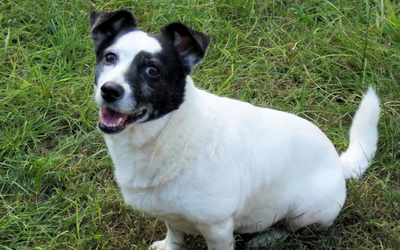
October 14th marks National Pet Obesity Awareness Day. Many us spend countless hours worrying about the health of our pets, but many of our pets are overweight or obese. According to a survey conducted in 2018 by the Association for Pet Obesity, an estimated 60% of cats and 56% of dogs in the US were overweight or obese. Pet obesity is an epidemic. “What’s one more treat?” you say. The reality is those extra treats add up and combined with too much food at mealtimes and a lack of exercise those extra treats translate in extra pounds. And those extra pounds are associated with serious health conditions.
Just what is considered obese? It actually doesn’t take a lot of extra weight in order for a pet to be considered overweight or obese. A pet is considered overweight when it’s 10% above its ideal weight and obese when it is 20% over its ideal weight. For example, if your cat’s ideal weight is 10 pounds, 12 pounds is considered obese. Many will comment “but it’s only 2 pounds!”, and granted, 2 pounds on an adult human is not significant, but on a 10-pound cat it is!
It’s so easy to over-feed your pet without even realizing it. We measure food with any old measuring cup, but these can inaccurately measure food and be a constant source of overfeeding. Using a measuring cup specifically designed for you pet’s brand of food or using a kitchen scale to accurately measure food ensures that you’re not accidentally overfeeding your pet.
As the weather changes in the fall and we head into winter, poor weather conditions (snow, ice, or persistent rainstorms) can deter even the hardiest of us dog walkers. A reduction in exercise without a corresponding reduction in the number of kibbles in your dog’s bowl can quickly lead to weight gain. If you’re aware that your pet’s exercise is reduced over the winter, ask your veterinarian if you should reduce your dog’s food by a few kibbles.
Pets that are overweight or obese can end up with serious health problems and their life expectancy can be reduced. Risks associated with obesity are:
- increased risk during surgery including complications due to decreased lung, kidney, or liver function.
- increased risk of diabetes.
- increased risk for high blood pressure, which can lead to increased risk of heart disease and kidney disease.
- a decreased immune response leading to difficulties in fighting infections.
- reduced endurance and exercise intolerance, worsening the problem.
- increased risk of arthritis, torn knee ligaments, and spinal problems.
- gastrointestinal problems including constipation.
- increased risk of cancer.
- increased risk of skin disorders.
Some steps to take to reduce the bulge with your pet:
- First, make an appointment with your veterinarian to determine if your pet is overweight. Your veterinary healthcare team can help you recognize if your pet is at his/her ideal weight by showing you how to check your pet’s Body Condition Score. Your healthcare team can help you devise a plan to reduce your pet’s weight if he’s carrying around an extra pound…or 5.
- Ensure you are feeding the appropriate amount of food. Carefully read the food bag or food can to determine the amount your pet needs each day. The instructions on the container are general guidelines; every pet’s requirements will be different (an active dog may need more, and a lapdog may need less). If you’re unsure, ask your veterinarian for help.
- Eliminate treats, at least until your pet’s weight is reduced. Then consider what you are feeding your pet as treats. Is it “junk food” or are they healthy treats? Many fruits and vegetables are safe for you pets and make great treats – ask your veterinarian what the best treats would be for your pet.
- Exercise! Take your dog for one extra walk in the day or extend each walk by a few minutes. Remember that the pace at which you walk will impact how much exercise your pet is actually getting. A slow meandering stroll around the block will not burn nearly as many calories as a brisk walk or jog of the same distance. Try playing interactive games with your cat, such as pounce games with a feather on a wand or roll balls for your cat to chase to increase exercise levels. Five minutes several times a day is all your cat may need to keep her in shape. Speak to your veterinarian about how you can gradually increase your pet’s exercise in a safe way.
Talk to your veterinarian today to determine the best feeding and exercise plan for your pet. Different life stages require different feeding regimes. Your veterinarian may recommend a therapeutic diet to help get your pet back on track with his/her weight. We all love our pets, want the best for them, and want to keep them in our lives for as long as possible. Ensuring your pet maintains a healthy weight is one way to help keep Fido or Kitty in your life for a long time.